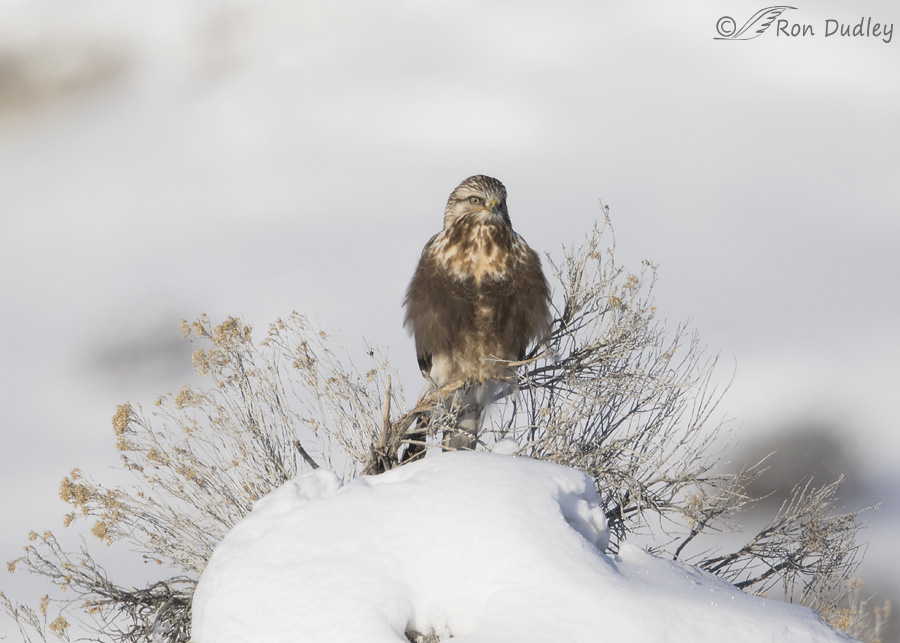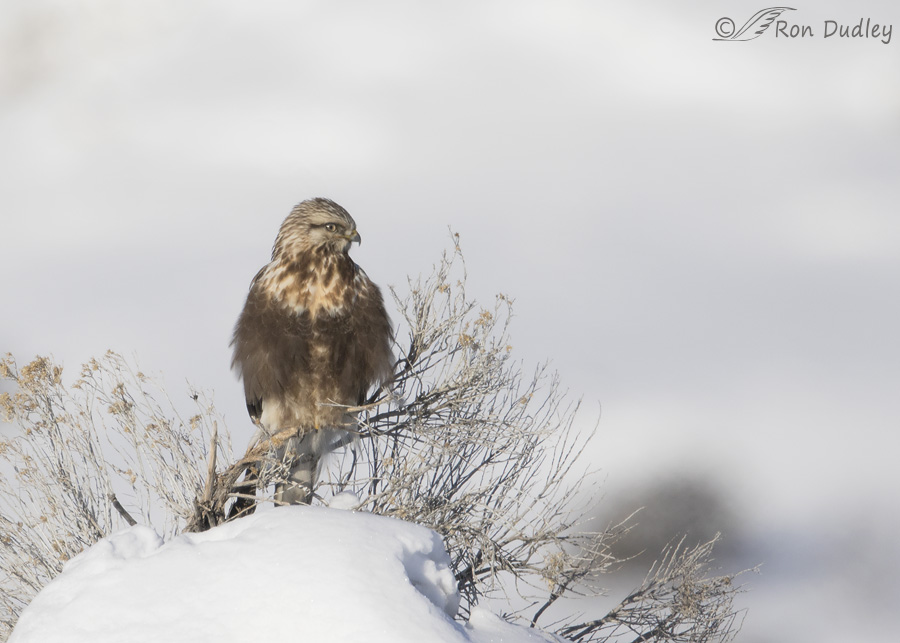Seldom are the settings as dominant as the birds in my images. These two are exceptions.
 1/3200, f/6.3, ISO 320, Canon 7D Mark II, Canon EF 500mm f/4L IS II USM + EF 1.4 III Extender, not baited, set up or called in
1/3200, f/6.3, ISO 320, Canon 7D Mark II, Canon EF 500mm f/4L IS II USM + EF 1.4 III Extender, not baited, set up or called in
I photographed this Rough-legged Hawk five days ago in sub-zero temperatures in a remote area of Box Elder County. The bird was perched on rabbitbrush that was half buried by a snowdrift and I thought the setting was fairly unique and quite interesting. I’ve cropped and composed the photo to include the half-circular rabbitbrush arch and as much of the snow mound as I could.
The weather conditions were extreme out there that day and I thought this photo reflected the mood well. In my images the avian subject is usually larger in the frame than this but here I think the rabbitbrush and snow are almost as important as the hawk. If the bird had largely filled the frame I believe the viewer would be deprived of important elements that contribute to the mood of the image and the harshness of the environment.
 1/3200, f/6.3, ISO 320, Canon 7D Mark II, Canon EF 500mm f/4L IS II USM + EF 1.4 III Extender, not baited, set up or called in
1/3200, f/6.3, ISO 320, Canon 7D Mark II, Canon EF 500mm f/4L IS II USM + EF 1.4 III Extender, not baited, set up or called in
When the hawk looked to its left it allowed me to compose the photo differently. Here the bird is a little larger in the frame and more of the background is out-of-focus snow but we’re missing the complete arch of the rabbitbrush, much of the snowbank and the intimacy provided by direct eye contact.
The first photo is my favorite of the two.
Ron
Note: That morning was one of the most frustrating experiences of my photographic career. After a dangerous drive of just under two hours over snowy roads to reach my destination and photographing many raptors after I finally got there (including a close Golden Eagle on a natural perch) nearly all of my 348 images taken with my 500mm lens were very soft. My shots of this bird were the only ones that were sharp. Mia had the same problem with her 500mm Nikon.
The culprit was air turbulence caused by the extreme temperatures (it was as low as -22° F that morning). After I arrived home and things “warmed up” a little I tested my gear at a local pond and my images were sharp again.
I suspect that some of my viewers who are photographers may have experienced similar problems with the extremes of weather we’ve been having the last few weeks.


Awesome
I like both of these photos Ron. Often I think showing more of the environment, or context that the subject is in helps convey the experience. In this case, a cold and snowy day.
Perhaps it was so cold that the RLHA did not skittishly fly away, like they seem to do with me, every time :-).
You captured the bird’s beauty. The first shot is my favorite, but both very nice!
I’m glad you like them, Jean. Thank you.
Ooooh.
And ahhh.
I am, as always, super impressed with both images, but lean towards the first.
It makes it so clear that birds endure stoically conditions which would have us hunkered down at home. Probably complaining.
And on yet another stinking hot day, I love looking at cool images…
Thanks, EC. For now it’s warmed up here significantly and that feels good after last week. The awful winds have finally died down too.
That snowman’s hair is standing on end for some reason…must have been watching TV and, like many of us, is scared out of his (her?) mind….
Really neat shots — you’ve definitely captured the frigid temps. Looks like the Roughie is trying to capture some body heat which may also contribute to the appearance of softness.
Thanks, Marty.
I’d take either of these photos. To me the difference is that the first one is more interactive and the second is a portrait. I do like seeing the surroundings clearly.
Thank you, Susan.
The temperatures here in SE Idaho have been the same, with similar photographic results. Another caveat to extreme winter cold is the auto exhaust that can sometimes envelope the whole car with a “cloud”
Don, That’s one of the reasons I always turn my engine off when photographing – no matter how cold it is. The other reason I do it is because engine vibration often contributes to soft images, especially at long focal lengths.
I love them both but I lean a little toward the second. Like the head angle and having the bird a little larger in the frame. The light is fantastic. Having never shot, nor probably ever will, in -22 degree weather, I don’t understand the “air turbulence” issue you are referring to. I continue to be amazed at the IQ you get with a 7Dii.
Frank,
Ed MacKerrow (a friend and authority on optics) explained it to me this way:
“Cold air also results in turbulence. Temperature gradients in the air are the culprit. Those can arise from hot ground or cold ground – air interfaces.
The effect is that turbulence bends the light ray through cells, or globules of air at different temperatures, and therefore different indexes of refraction. In Nevada we could actually see the size of these globules, they averaged about 0.5 meters across. They also moved with the wind.
We know that a longer optical path will result in more erratic refracting (bending) of the light as it goes through more of these globules.
The focal length effect makes sense when thinking about angular magnification. A deviation in angle of the light ray from the turbulence globules will be magnified by a longer focal length as compared to a shorter one. This is the part that was new for me… it explains a lot of my past frustrations and accusing my AF system to be broken :-)”
Thanks to you and Ed for sharing this, Ron. As you know, I am not a photographer, but I do a fair amount of scope-birding (sometimes necessary to “reach” distant birds, often because I don’t want to bother a perched bird), and frequently experience turbulence. This explains things very clearly (so,to speak ). And, I regularly lead small groups in a variety of weather/temperature conditions – now I’ll be able to let others know what is going on as well. Thanks again.
). And, I regularly lead small groups in a variety of weather/temperature conditions – now I’ll be able to let others know what is going on as well. Thanks again.
Cheers,
Dick
I’m glad you found this info as interesting and useful as I did, Dick. Thanks. And thanks again to Ed MacKerrow.
Interesting. Thanks for that explanation. Another reason not to go out in -22 weather unless you are doing close-ups of ice crystals.
Interesting to see how the Angie change really sets an entirely different tone.
Agreed, Arwen.
Beautiful! The first photo is just excellent showing both the bird and snow covered brush. Frustrating but at least you know what happened. Suspect the same issue when I was photographing some deer across the creek the other day.
“at least you know what happened”
Exactly, Judy. I’d be very distressed if I, with the help of others (especially Ed MacKerrow and Mia), hadn’t figured out the cause.
I’ve been surprised to learn how many other photographers have been having similar problems recently.